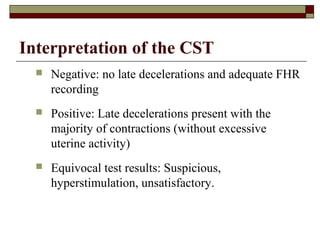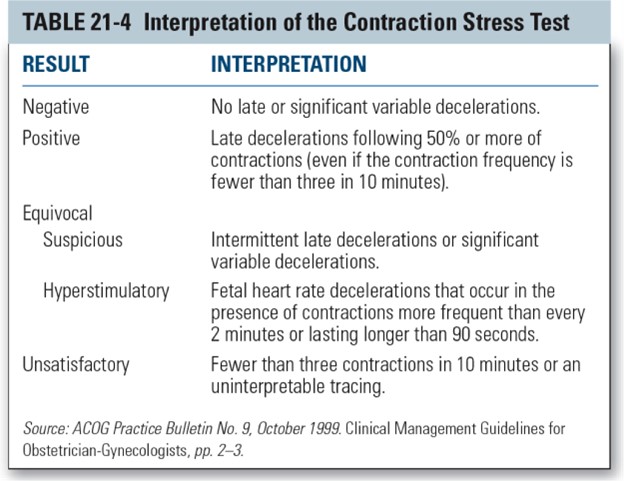A nurse is evaluating the results of a contraction stress test (CST) for a pregnant client who had a nonreactive or nonreassuring result on a nonstress test (NST).
The nurse notes that there are no late decelerations of the fetal heart rate (FHR) after three contractions in a 10-minute period.
How should the nurse interpret this finding?
Positive or abnormal
Negative or normal
Equivocal or suspicious
Unsatisfactory or incomplete
The Correct Answer is B
Negative or normal. This means that there are no late decelerations of the fetal heart rate (FHR) after three contractions in a 10-minute period, which indicates that the baby can tolerate the stress of labor contractions.
Choice A is wrong because positive or abnormal results mean that there are late decelerations of the FHR after three contractions in a 10-minute period, which suggests that the baby may be at risk of hypoxia or injury during labor.
Choice C is wrong because equivocal or suspicious results mean that there are either variable decelerations or late decelerations after fewer than half of the contractions, which require further testing or monitoring.
Choice D is wrong because unsatisfactory or incomplete results mean that there are either fewer than three contractions in a 10-minute period or poor quality of the FHR tracing, which prevent an accurate interpretation of the test.

Nursing Test Bank
Naxlex Comprehensive Predictor Exams
Related Questions
Correct Answer is B
Explanation
Negative CST.A negative CST means that the fetal heart rate does not slow down (decelerate) after a contraction, which indicates that the baby can tolerate the stress of labor.
This is a normal and reassuring result.
Choice A is wrong because a positive CST means that the fetal heart rate slows down and stays slow after more than half of the contractions, which indicates that the baby may be at risk for problems during labor.
This is an abnormal and concerning result.
Choice C is wrong because an unsatisfactory CST means that there are not enough contractions to produce a reliable result.
This may happen if the medication or nipple stimulation does not induce enough contractions, or if there are other factors that interfere with the test, such as maternal movement or fetal sleep.
Choice D is wrong because a suspicious CST means that the results are unclear or inconsistent.This may happen if the fetal heart rate slows down after some but not all of the contractions, or if there are other types of decelerations that are not clearly related to the contractions.
A suspicious CST may need to be repeated in a couple of days.

Correct Answer is A
Explanation
Place the device over the fetal back for 3 seconds.This is because vibroacoustic stimulation (VAS) is the application of a vibratory sound stimulus to the abdomen of a pregnant woman to induce fetal heart rate (FHR) accelerations.The presence of FHR accelerations reliably predicts the absence of fetal metabolic acidemia.VAS is typically used during a nonstress test (NST) to assess fetal well-being.The device should be placed over the fetal back for 3 seconds, as this is the optimal duration and location to elicit a fetal response.
Choice B is wrong because holding the device firmly against the maternal abdomen for 10 seconds may be too long and too strong for the fetus, and may cause discomfort or distress.
Choice C is wrong because moving the device around the maternal abdomen until fetal movement is detected may not be effective or efficient, as the device may not reach the optimal location or duration to stimulate the fetus.
Choice D is wrong because applying the device intermittently over the fundus for 15 seconds may not target the fetal auditory system, which is located near the fetal back, and may also be too long and too strong for the fetus.
Normal ranges for FHR are between 110 and 160 beats per minute, and FHR accelerations are defined as an increase of at least 15 beats per minute above baseline for at least 15 seconds.
Whether you are a student looking to ace your exams or a practicing nurse seeking to enhance your expertise , our nursing education contents will empower you with the confidence and competence to make a difference in the lives of patients and become a respected leader in the healthcare field.
Visit Naxlex, invest in your future and unlock endless possibilities with our unparalleled nursing education contents today
Report Wrong Answer on the Current Question
Do you disagree with the answer? If yes, what is your expected answer? Explain.
Kindly be descriptive with the issue you are facing.
